Abstract
The transportation sector is considered the number one consumer of tires worldwide. At present, 1.1 billion vehicles relying on this industry, although this number is increasing significantly following supply chain demands and the rapid economic growth. Among the main selection standards for fleet-operating enterprises are the quality, durability, and sustainability of tires, in efforts to ensure efficiency and safety for continuous operations. Lifecycle assessments (LCAs) are the optimal solution to optimize tire usage for extended performance and increased lifespan. In this paper, we developed a prediction model aiming at managing tires during the middle-of-life phase (use phase) while minimizing the negative environmental impact.
1. Introduction
A rise of global demand has generated an enormous pressure on supply chains, prioritizing efficiency and reliability at all costs. Consequently, resources are abundantly consumed, leading to a potential shortage of raw materials and generating waste that poses significant environmental and public health risks. Among supply chain stakeholders, transportation is a major consumer of raw materials, being responsible for about 15–30% of total resources consumed, including fuel, metals, tires, and other goods.
Diverse efforts have been made to reduce transportation resource consumption, such as route planning and scheduling, load consolidation, and the use of renewable energy. Still, the results are minor compared to the objectives of a circular economy (CE).
With regard to tire management through the CE concept, the notion of seven “Rs” has emerged: Reduce, Reuse, Recycle, Redesign, Renew, Repair, and Recover [1]. Generally, these practices are widely used during the production of tires and after their obsolescence. Despite some literature on tire lifecycle management, there remains a notable gap on monitoring, optimizing, and managing tires, specifically during their usage period. Consequently, we were compelled to explore this path further and develop a solution aimed at maximizing tire utilization before disposal.
In this paper, our aim is to deploy the CE concept through extending the lifetime of tires and generating value before recycling. This will allow transportation companies to optimize their tire consumption while monitoring maintenance intelligently, minimizing outlays, and guaranteeing security standards for operators and the fleet.
Section 2 presents the diverse works related to the different phases of the tire life cycle, i.e., beginning of life (BoL), middle of life (MoL), and end of life (EoL), focusing on an effective circular economy (CE). Section 3 describes the applied methodology and the proposed solution. Section 4 discusses the use case of our decisional assistant design, applied to a real transportation firm, followed by the results of our study. Section 5 concludes by reflecting on the main contributions of this paper and potential directions to improve the study.
2. Related Works
In this section, we introduce the lifecycle assessment approach (LCA) as applied to tires and present the diverse contributions of academics to optimize the appropriation of tires throughout their life span.
In an effort to integrate the CE concept, a meticulous assessment and solutions were conducted by several researchers in each step of the tire life cycle known, i.e., BoL, MoL, and EoL.
2.1. BoL Phase
BoL refers to the first stage in design and manufacturing, where enhancing sustainability is a primary role for the green production of tires [2]. Many solutions have been developed considering environmental and technological aspects, for instance, the use of carbon black material via thermolysis as a reinforcing filler in tires, which minimizes costs and reduces reliance on virgin materials [3].
Shahpas and et al. investigated the impact of deploying 3D printing technology on environmental and economical dimensions. In their study, it was concluded that applying this technology to a closed-loop supply chain (CLSC) designed by the authors could help shift the supply chain to a more agile structure and help reduce carbon emissions by 9–10% [4].
Moreover, the elimination of tire defects during production was the focus of Oliveira et al., who used machine learning algorithms to achieve an accuracy of 92% and 96% [5]. An automated quality analysis and assurance tool to detect anomalies in tire tread production was presented by Stanković et al., reducing the time spent on manual comparisons by the quality team [6].
2.2. MoL Phase
The MoL phase refers to the active period of a tire’s use. It is considered the most challenging stage in the product’s LCA, as it requires careful monitoring to ensure optimal performance and minimizing potential risks during operation.
Tires equipped with sensors are called “Intelligent tires”. As stated by Pohl et al., they represent a new monitoring method using passive radio requestable SAW (Surface Acoustic Wave) sensors for proficient monitoring [7].
Pohl et al. proposed a novel approach to track tire–road conditions through the development of an intelligent tire prototype, i.e., the KU-iTire, which utilizes advanced simulation techniques (AbaqusCAE and AbaqusExplicit) to analyze the nonlinear behavior of tires under various driving scenarios, providing valuable insights into tire dynamics [8].
Moffitt et al. also presented chromasonic sensors based on acoustic emissions, acceleration sensing, force/friction sensing, and strain sensing for tire monitoring, helping to predict and prevent potential failures [9].
In order to maximize the efficiency of vehicle handling and safety, Salari et al. proposed dynamic control through advanced modeling and real-time estimation techniques via artificial neural networks (ANN) and deep learning, demonstrating superior performance [10].
2.3. EoL Phase
Waste tires are non-biodegradable, hazardous waste, of which approximately 4 million tons are generated worldwide annually. It is a global environmental responsibility to handle this residue with a sustainable approach.
Hu et al. focused on the waste tire valorization process, proposing a valorization framework with technological enhancement, integrating data-driven methods and multi-objective optimization models [11].
Manupati et al. developed a prediction model to enhance the efficiency of tire remanufacturing, aiming to remodel reverse logistics networks in India [12].
Abbas-Abadi et al. highlighted advancements in enhancing the recyclability of end-of-life tires, emphasizing the potential of retreading and powdering methods for material separation [13].
Subulan et al. presented a comprehensive modeling approach for managing scrap tires, integrating multiple recovery options like recycling and energy recovery. Their study included data-driven insights regarding costs, selling prices, and transportation, aiming to help practitioners make decisions in tire management in the EoL phase [14].
Figure 1 summarizes the core principals of LCA for tires during the different phases.
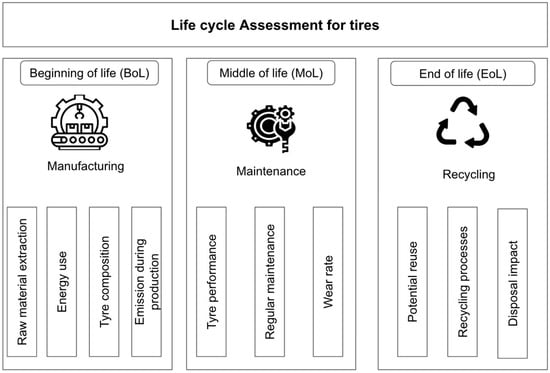
Figure 1.
Core principals of LCA for tires during the BoL, MoL, and EoL phases.
The reviewed literature primarily concentrates on the BoL and EoL phases of tires, while the MoL phase remains largely understudied, highlighting a gap in our current understanding. Although many researchers have collected data on tire usage, there have been limited efforts to effectively harness this information using artificial intelligence algorithms for practical implementation.
3. Methodology and Proposition
In this section, we propose a methodology based on artificial intelligence to assist Transport executives in the MoL phase of tires in better exploiting these items. Stakeholders such as maintenance managers or fleet managers play a crucial role in overseeing tire usage, maintenance, and replacement. Their decisions directly impact cost efficiency, safety, and sustainability, making data-driven insights essential for optimizing operations.
Machine Learning (ML) has evolved considerably, and within this dynamic field, automation of the learning process, also known as Automated Machine Learning (autoML) [15], has emerged as a revolutionary sub-discipline. AutoML addresses the complex challenge of making machine learning techniques more accessible, efficient, and adaptable to a variety of users, while accelerating the model development cycle. In our proposal, autoML offers several advantages that could be innovative for the tire management sector. Firstly, autoML can automate the process of selecting the best machine learning models, which can lead to more accurate predictions and insights without requiring wide expertise. This can be particularly beneficial for predicting tire wear, optimizing recycling processes, or forecasting demand and supply in the tire industry. Secondly, autoML can significantly reduce the time and resources required for data preprocessing, model training, and hyperparameter tuning. This efficiency can lead to faster decision-making and more agile responses to industry challenges. Lastly, with its ability to handle large datasets, autoML can uncover hidden patterns and relationships in the data, providing deeper insights into tire performance, lifecycle, and environmental impact.
Incorporating autoML into the tire management domain could lead to more sustainable practices, optimized operations, and a deeper understanding of the entire tire lifecycle.
The stakeholder is prompted to make decisions on the basis of the flow of information received, as shown in the Figure 2. Faced with large volumes of data to process and complex situations to analyze, stakeholders can be assisted in their decision-making. Such assistance must be able to analyze a flow of information from several sources (user instances, past experience, customer feedback, etc.). In this context, data analytics and machine learning approaches can be particularly useful.
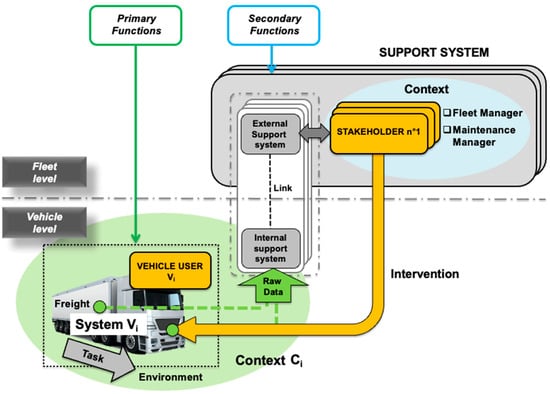
Figure 2.
The informational and decisional flow.
As exhibited Figure 3, the proposed decisional assistance comprises off-line and on-line phases. The goal of the off-line phase is to exploit global information to build a pertinent assistance framework using the AutoML approach. This decisional assistance is then used on-line by the stakeholder. Before presenting the architecture used to develop the AutoML decisional assistance, the models used in the decisional process will first be described.

Figure 3.
Illustration of the assistance design and operation phases.
3.1. The Proposed AutoML Framework
The proposed AutoML framework aims to autonomously produce decision-making rules for tire management. The AutoML assembles the necessary modelling steps as an end-to-end machine learning pipeline and automates the pipeline to obtain the features, algorithms, and hyperparameters that return the best performance, as measured on validation datasets.
The integration of AutoML approaches in decision support aims to assist stakeholders by augmenting and structuring relevant information. As depicted in Figure 3, the decision support process can be delineated into two distinct phases:
Design phase: By mainly exploiting static information structures and a dynamic data history (from the “target” system or a fleet of equivalent systems), a decision assistance system was designed to generate the various outputs (e.g., thresholds, rules, and semantic links) which will be used by the part of the decision-making process leading to a decision. In the present work, we are interested in a decision-making process based on the use of rules. Assistance is provided by generating a set of “if–then” rules placed in a specific order.
Use phase: As shown in Figure 3, the assistant uses the information elements that is has at its disposal (static information structure (SIS), dynamic information structure (DIS), and exchanges between systems within a collaborative space). Depending on the cognitive level considered, these data are compared with thresholds or are used to validate a set of rules or semantic links in order to make a decision. The decision may be taken entirely automatically (i.e., without any intervention from the expert) or in conjunction with the expert. In this case, the information elements (e.g., valuations of semantic links between entities) must be presented to the expert in the most comprehensible way possible.
3.2. Steps of AutoML
3.2.1. Model Selection
This step addresses data-related issues such as missing values, outliers, and noisy or altered data. To handle the problem of missing values in data preprocessing, AutoML employs techniques such as missing value imputation. Imputation involves estimating or replacing missing values with values computed from other observations in the dataset. Various approaches can be used for missing value imputation, such as mean or median imputation or regression imputation [16].
3.2.2. Hyperparameter Optimization
This second step allows for the automatic selection of the algorithm to be used, as well as the optimal configuration of hyperparameters (i.e., the adjustable parameters of the algorithm) to achieve good learning performance.
Figure 4 illustrates the different steps of this selection process:
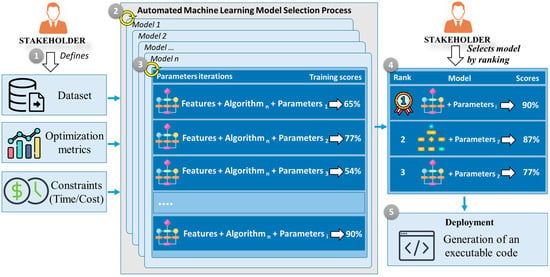
Figure 4.
The successive steps of the AutoML process.
Step 1: The stakeholder defines the optimization metrics used to evaluate the results (e.g., accuracy, F1-score, R2, Mean Squared Error) [17]. They also set constraints regarding time or cost (e.g., maximum processing time) that the AutoML process must adhere to.
Step 2: The model selection process is treated as a single hyperparameter optimization (HPO) problem within a hierarchical configuration space. The first iteration selects an algorithm (model {1,2,…,n}), while the second iteration selects the corresponding hyperparameters (parameters {1,2,…,i}).
To handle such complex and structured configuration spaces, different optimization algorithms can be used, such as:
Random Search [18,19]: Defines the search space as a bounded domain of hyperparameter values and randomly samples point within it.
Grid Search [20,21]: Defines the search space as a grid of hyperparameter values and evaluates each position within the grid.
More advanced methods such as Bayesian optimization and evolutionary optimization are sometimes used [18].
3.2.3. Evaluation
The AutoML process ultimately provides a ranking of the best-selected models based on the optimization metrics and constraints defined in the first step. The stakeholder then selects the model with the highest score (Step 4 in the figure).
3.2.4. Deployment
Finally, the stakeholder can implement the generated model in a development environment, as the most advanced AutoML tools provide executable code (Step 5 in Figure 4).
4. Use Case
The use case concerns a fleet of vehicles transporting hazardous substances. Operational information related to the transport of hazardous substances is provided by STMF [22,23], a leading Moroccan company in this sector.
More specifically, the application case focuses on the management of truck tires, given that tire failures can have dramatic consequences. Ensuring a high level of vehicle reliability is a very important parameter for successful delivery missions. A minor accident, such as a burst tire, can cause the tank containing the hazardous substance to detach, with dramatic consequences for the transport company, other road users, and the environment.
The primary objective is to diagnose tire condition to estimate their remaining lifespan and determine the number of kilometers left before they are deemed unserviceable.
This case study highlights the challenge of managing a fleet of more than 288 vehicles, with around 3456 tires in operation and around 100 in stock. In addition, each vehicle is associated with a set of information linked to its specific environment, such as the task performed, the driver operating it, and the context in which it operates. To facilitate decision-making, the aim is to create a decision support system that is capable of providing decision support elements for STMF’s maintenance center.
For example, in the case of a truck operating in an environment where the roads are particularly degraded, the information associated with this truck may indicate faster tire wear compared with other vehicles operating on less degraded roads. The decision support system can take these data into account and recommend more frequent tire rotation for this truck in order to prevent tire failures and optimize tire life.
In addition, assistance can also take into account the characteristics of drivers. For example, if a driver tends to drive aggressively, this can lead to premature tire wear. By monitoring and analyzing data relating to each driver’s driving behavior, assistance can identify drivers who require additional training in terms of good driving practices in order to minimize tire wear and improve the overall safety of the fleet while minimizing the negative impact on the environment.
By combining information specific to each vehicle, driver, and their context, the assistance system provides decision-support elements to the various STMF stakeholders, particularly those in the maintenance center. This makes it possible to effectively plan fleet maintenance based on tire diagnostics and other relevant parameters (e.g., weather forecasts, mission planning, etc.), thereby reducing the risk of accidents linked to tire failure, avoiding unplanned truck downtime, and optimizing tire use by replacing tires at the right time, rather than systematically.
4.1. Design of Decisional Assistance
4.1.1. Overview of Tire Management
This study focuses on heavy goods vehicles whose primary function is to transport goods from a point of departure to a destination. The focus is on the tires of these vehicles, i.e., a sub-system that brings the vehicle into contact with the road surface which is of vital importance in ensuring the safety of the vehicle and the goods being transported (e.g., dangerous goods).
Each vehicle consists of a tractor unit and a trailer. The tractor consists of two axles, one of which is removable (i.e., the steering wheel axle used to steer the vehicle). The trailer has three axles, one of which is generally liftable (i.e., the axle is automatically raised or lowered if load conditions allow). We assume that all axles have single wheels, so a vehicle has ten tires in total.
The vehicle fleet decomposition tree is shown in Figure 5, with the systems and sub-systems considered in the study indicated in orange.

Figure 5.
Composition of the truck system.
4.1.2. The Different Tire Swapping Strategies
The Maintenance Manager’s role is crucial in guaranteeing the safety and compliance of vehicles when transporting hazardous substances. As far as the tires of the vehicle fleet are concerned, the main objective of the maintenance manager is to keep them in good working state in order to minimize the potential risks associated with their wear or failure. That person ensures that the vehicle tires (i.e., tractors and trailers) are regularly inspected for signs of wear (using depth gauges; see Figure 6), damage, or deterioration. Visual and physical checks are then carried out to ensure that the tires are in good condition and that they meet the required safety standards (i.e., compliance with the maximum tolerated wear). This stakeholder implements a preventive maintenance program for tires, including actions such as regular tire rotation, air pressure checks, and wheel balancing and alignment. These measures help to extend tire life and prevent potential problems (e.g., tire blow-out). He also ensures that there are always spare tires available in case of an urgent need for replacement. The Maintenance Manager is also responsible for requesting the supply of new tires, in advance, by communicating purchase requests to the Stock Manager.

Figure 6.
Example of a tire wear gauge.
The need associated with the Maintenance Manager are related to improving tire life by developing tire rotation recommendations. Specific instructions (i.e., rules) can be generated according to the type of tire degradation for moving tires from one position to another on the vehicle and taking into account the state of the tire degradation (see Figure 7) and the recommended rotation patterns (see Figure 8). This ensures more uniform wear and longer tire life.

Figure 7.
Different types of wear on trailer axles.

Figure 8.
Possible permutation strategies.
As shown in Figure 8, several tire rotation strategies are possible:
(1) Rotating the tires on the rims while maintaining their position on the vehicle is a common practice that helps combat one-sided shoulder wear and can also be beneficial in applications where the tires are susceptible to excessive sidewall wear or abrasions.
(2) Rotating the right and left tires on the same axle helps to equalize the effects of wear rates resulting from road characteristics such as camber or sidewall abrasion caused by curbs (typically in urban applications).
(3) Rotating outer and inner tires evens out the wear between the twin tires and brings the outer sidewall to the inside.
(4) Swapping tires from one axle to another maximizes tire life between the first and second steering axles on 6 × 2 tractors, where differences in cornering forces result in higher wear rates on the steering axle. This strategy is also used to swap a tire with another tire on the same axle or another axle on the trailer. The case of swapping steering tires does not concern STMF, which operates a fleet of tractors with a single steering axle. However, it is possible to swap trailer tires.
(5) Swapping trailer tires from axle 1 (V111) to axle 3 (V113), from axle 3 (V113) to axle 2 (V112), and from axle 2 (V112) to axle 1 (V111) maximizes the life and resistance to irregular wear of all the trailer’s axles.
4.2. The Generation of Rule-Based Decision Assistance
As explained in the first section, the Maintenance manager is not an expert in data analysis. Hence, the intervention of a data analytics expert is not favored. The AutoML approach is therefore used. The various assistance generation parameters are then presented.
4.2.1. The Data Set
The dataset concerns the history of tire rotation interventions which provided the best performance in terms of tire consumption over a one-year horizon. The first category of attributes, taken into consideration in the study and presented in Figure 9, concerns axle condition. The condition of an axle is the average of the current tread depth of the tires on both sides of the axle in question. The second category concerns the difference in wear between the two tires on the same axle. The conditions and gaps of the front, central, and rear axles are considered. The last category is the target variable, which is the decision to be taken. Two permutation strategies are considered. First, PERMU_X combines strategy (2) and (4) (see Figure 8). This decision consists of identifying a tire with significant wear and swapping it with another tire (i.e., the other tire on the same axle or on another axle) while respecting the wear gap on the same axle. Second, PERMU_E refers to the permutation strategy (5). It consists of swapping the tires on the front axle with those on the rear axle, the tires on the rear axle with those on the central axle, and the tires on the central axle with those on the front axle.

Figure 9.
Extract from the historical database of tire rotation operations.
4.2.2. Data Preparation
Historical data on tire repairs are entered into a dedicated application and stored in a MySQL database. Data cleaning and the imputation of missing data are not necessary in this application.
4.2.3. Model Development
The FLAML library [24] is used to design a predictive classification model in order to generate a decision tree for use in decision assistance. Three requirements must be met before the self-learning process can be launched.
The data source: The data source will be the dataset presented in the previous section.
The optimization metric: Accuracy is used to compare the different algorithms proposed by AutoML.
The time constraint: This need of the Maintenance Manager is handled each time the truck returns from a mission. The stakeholder then has to make a rotation decision quickly in order to preserve the appropriate human resources to carry out the tire rotations. The AutoML execution time constraint is set at 2 min.
Figure 10 summarizes the simplified configuration of the AutoML process. Figure 11 shows the configuration of the FLAML library.
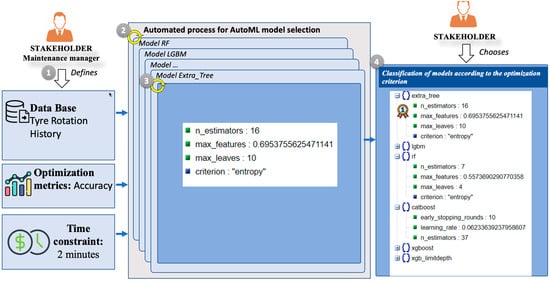
Figure 10.
Illustration of the AutoML configuration for the STMF application case requirement.
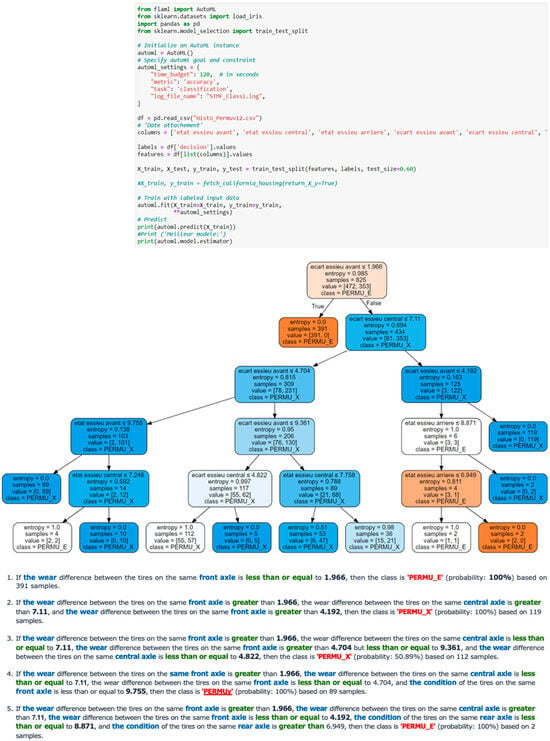
Figure 11.
Code associated with the development of the autoML model for the requirement (top). The decision tree generated and extraction of the rules (bottom).
4.2.4. Results
The Extra_tree algorithm is ranked first according to the Accuracy optimization metric. The best hyper-parameterization associated with the study dataset is presented in Table 1.

Table 1.
Optimal hyper-parameterization of the Extra tree algorithm for the requirement.
Table 2 presents the confusion matrix associated with the test dataset (50% of the initial dataset). The different evaluation criteria are compared in Table 3. With an Accuracy of 90%, the developed decision tree can be considered highly relevant. In the next section, its use will demonstrate its effectiveness in improving tire life. Figure 11 shows the decision tree generated and an extract of the procedural rules deduced from this tree.

Table 2.
Confusion matrix associated with needs.

Table 3.
Comparison of evaluation criteria.
4.3. The Exploitation of Decisional Assistance
In this phase, and as explained in Figure 12, with reference to the AADA model, the Acquisition and Analysis phases are handled by the M1 and M2 artificial entities, while Decision and Action are entrusted to the stakeholder him/herself:
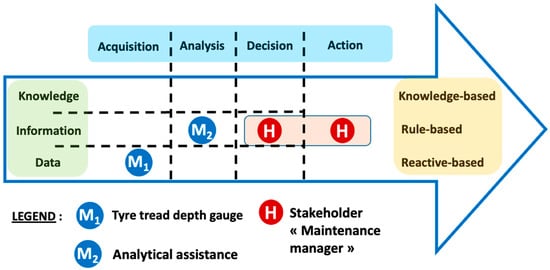
Figure 12.
Model of cooperation between humans and machines.
Acquisition concerns dynamic information elements: Each time a vehicle returns from a mission, a systematic inspection is carried out. During this inspection, the depth of the tire tread is measured using an electronic gauge. The vehicle’s odometer is also read and its value updated in the database.
The data are analyzed using the decision support system that has been developed. The output of this phase consists of a decision tree containing the various procedural rules and conditions to be followed in order to make a permutation decision. The decision support proposes (i.e., “prescribes”) permutation strategies according to the current situation.
The rule-based decision is taken by the stakeholder by applying the rules generated by the assistance system. As vehicle tires are crucial to safety, it is the stakeholder’s responsibility to decide whether or not to apply a recommendation proposed by the decision support system.
The action is entrusted to the maintenance stakeholder, who draws up the maintenance order to be carried out by the mechanics to rotate the tires.
4.4. Experimentation with Decision Assistance
The lifespan of a tire, which can be up to 2 years, makes it difficult to evaluate the decision-making assistance generated in the immediate future. A simulation model (Figure 13) based on a multi-agent system was therefore developed in order to evaluate the decision-making assistance according to the different missions within STMF and the legislation concerning tires and tire degradation.

Figure 13.
Simulation tool interface.
4.4.1. Simulation Settings
Table 4 shows the different agents and their parameters used for the simulation.

Table 4.
Simulation parameters.
The French regulations concerning the tires and axles of heavy goods vehicles in are set out in “le Code de la route” and “le Code de la sécurité routière”. The extracts relevant to our case study are explained below.
Tire wear: The tires must have a minimum tread depth of 1.6 mm over the entire tread. However, for the experiment, the tire replacement threshold is set at 3 mm to ensure better grip and safety.
Tire rotation: At the time of rotation, the difference between the depth of the main grooves of two tires mounted on the same axle must not exceed 5 mm (Figure 14).

Figure 14.
Depth of tread pattern on the same axle.
4.4.2. Disruptions
Two types of disturbance are considered:
- Internal disturbances, caused by one of the factors in the system (i.e., aggressive driving, damage to the steering or suspension system, etc.). This type of disturbance increases the rate of tire damage per kilometer by 5%.
- External disturbances (i.e., road conditions, external temperature, etc.). These disturbances increase the rate of tire wear by 3%.
4.4.3. Results
Table 5 presents the simulation results, considering a one-year horizon. The use of the developed decision support system has made it possible to increase tire life by 3604 km (difference between scenarios 1 and 4), resulting in a saving of 80 tires per year. With an average tire cost of 500 euros and an average intervention cost of 20 euros, the use of decision support will generate a saving for STMF of around 27,120 euros per year. This saving will also be accompanied by a reduction in environmental impact through improved tire utilization.

Table 5.
Simulation results.
5. Conclusions
In this paper, we propose a decisional process based on an AutoML model aiming at handling tires for transportation companies during their middle of life using a circular economy concept. The existing literature predominantly focuses on optimizing tire lifespan during the beginning of life and end of life phases, with limited attention given to the middle of life stage of the tire’s performance.
In this paper, we used a data-driven strategy to help decision makers optimize tire usage and maintenance, ensuring optimal conditions and reducing costs.
The proposed solution was implemented and tested in STMF with 20 vehicles. This subset of the fleet was identified by the maintenance department at STMF, who provided the relevant data for comparison with the simulation results throughout the study. The simulation results, based on a one-year horizon, revealed that the use of our decision support system would extend tire life by an average of 3604 km. This extension led to a significant reduction in tire consumption, saving approximately 80 tires per year. Given an average tire cost of 500 euros and an intervention cost of 20 euros, our model enabled STMF to achieve an annual financial saving of approximately 27,120 euros. Additionally, optimizing tire utilization contributes to reducing the environmental footprint by minimizing resource consumption and waste generation. The above results demonstrate the effectiveness of our approach in real-world scenarios.
Our AutoML approach is particularly engineered for non-experts in data analytics, offering simplified model configuration and automated deployment, thereby reducing technical complexity. This enhances accessibility and facilitates seamless integration into operational workflows.
These findings highlight the potential of AutoML-driven decision support systems in enhancing operational efficiency and sustainability within transportation companies. Future work will explore further refinements to the model by incorporating additional predictive factors, such as weather conditions and road quality, to further improve decision-making and cost-effectiveness. Moreover, expanding the study to a larger fleet and integrating real-time data streams could enhance the model’s adaptability and robustness.
Our research underscores the importance of intelligent data-driven strategies in circular economy applications, demonstrating that automated machine learning can effectively support industrial decision-making, optimize resource utilization, and promote sustainable practices.
Possible future directions will consider the upgrade of our proposed approach, with a focus on enhancing its adaptability to other cases, making it more general and versatile for a wider range of applications. The deployment of an AI agent, particularly in the knowledge-based decisional level, will enhance efficiency and assist stakeholders via a finer user experience.
Author Contributions
Conceptualization, I.M. and F.A. and Y.S. and B.A.E.M.; software, C.Z.; writing—original draft preparation, F.A. and I.M.; supervision, Y.S. and B.A.E.M. and A.E.O. and M.A. funding acquisition, F.A. All authors have read and agreed to the published version of the manuscript.
Funding
This research received no external funding.
Institutional Review Board Statement
Not applicable.
Informed Consent Statement
Not applicable.
Data Availability Statement
The data presented in this study are available on request from the corresponding author due to the data used is generated from the simulation tool.
Conflicts of Interest
The authors declare no conflicts of interest.
References
- Tamborski, M.; Rojek, I.; Mikołajewski, D. Revolutionizing Tire Quality Control: AI’s Impact on Research, Development, and Real-Life Applications. Appl. Sci. 2023, 13, 8406. [Google Scholar] [CrossRef]
- Buadit, T.; Ussawarujikulchai, A.; Suchiva, K.; Papong, S.; Rattanapan, C. Green productivity and value chain analysis to enhance sustainability throughout the passenger car tire supply chain in Thailand. J. Open Innov. Technol. Mark. Complex. 2023, 9, 100108. [Google Scholar] [CrossRef]
- La Rosa, A.; Pergolizzi, E.; Maragna, D.; Recca, G.; Cicala, G. Reuse of carbon black from end-of-life tires in new pneumatic formulations and life-cycle assessment of the thermolysis process. J. Elastomers Plast. 2019, 51, 740–754. [Google Scholar] [CrossRef]
- Shahpasand, R.; Talebian, A.; Mishra, S. Investigating environmental and economic impacts of the 3D printing technology on supply chains: The case of tire production. J. Clean. Prod. 2023, 390, 135917. [Google Scholar] [CrossRef]
- Oliveira, R.M.A.; Sant’Anna, Â.M.O.; Da Silva, P.H.F. Explainable machine learning models for defects detection in industrial processes. Comput. Ind. Eng. 2024, 192, 110214. [Google Scholar] [CrossRef]
- Stanković, K.; Jelić, D.; Tomašević, N.; Krstić, A. Manufacturing process optimization for real-time quality control in multi-regime conditions: Tire tread production use case. J. Manuf. Syst. 2024, 76, 293–313. [Google Scholar] [CrossRef]
- Pohl, A.; Steindl, R.; Reindl, L. The “intelligent tire” utilizing passive SAW sensors measurement of tire friction. IEEE Trans. Instrum. Meas. 1999, 48, 1041–1046. [Google Scholar] [CrossRef]
- Bastiaan, J.; Chawan, A.; Eum, W.; Alipour, K.; Rouhollahi, F.; Behroozi, M.; Baqersad, J. Intelligent Tire Prototype in Longitudinal Slip Operating Conditions. Sensors 2024, 24, 2681. [Google Scholar] [CrossRef] [PubMed]
- Moffitt, R.D.; Bland, S.M.; Sunny, M.R.; Kapania, R.K. Sensor Technologies for Direct Health Monitoring of Tires. In Encyclopedia of Structural Health Monitoring; Boller, C., Chang, F., Fujino, Y., Eds.; Wiley: Hoboken, NJ, USA, 2008; ISBN 978-0-470-05822-0. [Google Scholar]
- Salari, A.H.; Mirzaeinejad, H.; Mahani, M.F. Tire normal force estimation using artificial neural networks and fuzzy classifiers: Experimental validation. Appl. Soft Comput. 2023, 132, 109835. [Google Scholar] [CrossRef]
- Hu, Y.; Yu, X.; Ren, J.; Zeng, Z.; Qian, Q. Waste tire valorization: Advanced technologies, process simulation, system optimization, and sustainability. Sci. Total Environ. 2024, 942, 173561. [Google Scholar] [CrossRef] [PubMed]
- Manupati, V.K.; Kulatunga, A.K.; Ray, P.; Rofin, T.M. Sustainable management of EOL tyres: A remanufacturing supply chain network design. J. Clean. Prod. 2024, 434, 140115. [Google Scholar] [CrossRef]
- Abbas-Abadi, M.S.; Kusenberg, M.; Shirazi, H.M.; Goshayeshi, B.; Van Geem, K.M. Towards full recyclability of end-of-life tires: Challenges and opportunities. J. Clean. Prod. 2022, 374, 134036. [Google Scholar] [CrossRef]
- Subulan, K.; Taşan, A.S.; Baykasoğlu, A. Designing an environmentally conscious tire closed-loop supply chain network with multiple recovery options using interactive fuzzy goal programming. Appl. Math. Model. 2015, 39, 2661–2702. [Google Scholar] [CrossRef]
- Bahri, M.; Salutari, F.; Putina, A.; Sozio, M. AutoML: State of the art with a focus on anomaly detection, challenges, and research directions. Int. J. Data Sci. Anal. 2022, 14, 113–126. [Google Scholar] [CrossRef]
- Mallouk, I.; Sallez, Y.; El Majd, B.A. AutoML Approach for Decision Making in a Manufacturing Context. In Service Oriented, Holonic and Multi-Agent Manufacturing Systems for Industry of the Future; Borangiu, T., Trentesaux, D., Leitão, P., Berrah, L., Jimenez, J.-F., Eds.; Studies in Computational Intelligence; Springer Nature: Cham, Switzerland, 2024; Volume 1136, pp. 151–163. ISBN 978-3-031-53444-7. [Google Scholar]
- Jiao, Y.; Du, P. Performance measures in evaluating machine learning based bioinformatics predictors for classifications. Quant. Biol. 2016, 4, 320–330. [Google Scholar] [CrossRef]
- Zhang, Q.; Hu, W.; Liu, Z.; Tan, J. TBM performance prediction with Bayesian optimization and automated machine learning. Tunn. Undergr. Space Technol. 2020, 103, 103493. [Google Scholar] [CrossRef]
- Automated Machine Learning: Methods, Systems, Challenges; Hutter, F., Kotthoff, L., Vanschoren, J., Eds.; The Springer Series on Challenges in Machine Learning; Springer International Publishing: Cham, Switzerland, 2019; ISBN 978-3-030-05317-8. [Google Scholar]
- Liu, R.; Liu, E.; Yang, J.; Li, M.; Wang, F. Optimizing the Hyper-parameters for SVM by Combining Evolution Strategies with a Grid Search. In Intelligent Control and Automation; Huang, D.-S., Li, K., Irwin, G.W., Eds.; Lecture Notes in Control and Information Sciences; Springer: Berlin/Heidelberg, Germany, 2006; Volume 344, pp. 712–721. ISBN 978-3-540-37255-4. [Google Scholar]
- Shekar, B.H.; Dagnew, G. Grid Search-Based Hyperparameter Tuning and Classification of Microarray Cancer Data. In Proceedings of the 2019 Second International Conference on Advanced Computational and Communication Paradigms (ICACCP), Gangtok, India, 25–28 February 2019; pp. 1–8. [Google Scholar] [CrossRef]
- Mallouk, I.; Abou El Majd, B.; Sallez, Y. Optimization of the maintenance planning of a multi-component system. MATEC Web Conf. 2018, 200, 00011. [Google Scholar] [CrossRef]
- Mallouk, I. Modélisation d’une Assistance Décisionnelle Basée sur L’intelligence Artificielle Pour les Systèmes Cyber-Physiques: Application à la Maintenance dans le Domaine du Transport. Ph.D. Thesis, Université Polytechnique Hauts-de-France, Valenciennes, France, Université Mohammed V (Rabat), Rabat, Morocco, 2023. [Google Scholar]
- Wang, C.; Wu, Q.; Weimer, M.; Zhu, E. FLAML: A Fast and Lightweight AutoML Library. arXiv 2019, arXiv:1911.04706. [Google Scholar] [CrossRef]
Disclaimer/Publisher’s Note: The statements, opinions and data contained in all publications are solely those of the individual author(s) and contributor(s) and not of MDPI and/or the editor(s). MDPI and/or the editor(s) disclaim responsibility for any injury to people or property resulting from any ideas, methods, instructions or products referred to in the content. |
© 2025 by the authors. Licensee MDPI, Basel, Switzerland. This article is an open access article distributed under the terms and conditions of the Creative Commons Attribution (CC BY) license (https://creativecommons.org/licenses/by/4.0/).